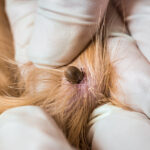Ticks are not only annoying, but can also pose a severe health threat to your dog. Ticks can transmit Lyme disease, Rocky Mountain spotted fever, and ehrlichiosis. While taking preventative measures, such as using tick-preventative products and avoiding high-risk areas, can reduce the chances of ticks causing your dog harm, you should also check your dog daily for ticks. We offer seven places to look for ticks on your dog and advice on what to do if you find a tick.
Seven Steps to Check for Ticks on a Dog
Ticks are most active in Ohio from early spring to late fall. During tick season, it’s a good idea to inspect your dog daily for ticks and to look for ticks after the dog has been in areas with tall grass, in the woods, or meadows.
Ticks are usually dark, flat, and oval. Depending on the variety, they may be as small as a sesame seed or as large as an apple seed. Once a tick embeds itself into the dog’s skin, it begins feeding on blood and will become rounded and engorged. The longer the tick remains embedded, the greater the chance that an infected tick will spread the disease.
When inspecting for ticks, start with a visual inspection. Follow that with a hands-on inspection. Here are common places to find ticks on your dog.
- Check between your dog’s toes and around their paw pads for ticks.
- Inspect your dog’s ears, eyes, mouth, and face to spot any ticks.
- Look between your dog’s shoulder blades, around the neck area, and along the back.
- Part the fur on your dog’s body to look for ticks on the skin.
- Examine other commonly overlooked areas, such as the armpits and groin.
- Conduct a thorough check of your pet’s belly and legs.
- Feel for small bumps that may indicate a tick bite by running your hands along your pet’s fur.
What to Do if You Find a Tick on Your Dog
If you find an unattached tick on your dog, remove it with tweezers. If using your fingers, wear gloves to reduce the chances of disease transmission. Dispose of the tick by flushing it down the toilet.
If the tick is embedded or attached, use tweezers to grip it as close to your dog’s skin as possible and pull it straight out, ensuring that the tick’s head is removed. Be cautious not to crush or twist the tick, as this could increase the chances of transmitting any diseases the tick may have been carrying. The tick can be flushed down the toilet. If you’ve been in an area with high incidences of tick-borne diseases, you may put it in a container for later identification by your vet. As a precaution, write down the date the tick was removed.
What are Signs Your Dog May Have a Tick-Borne Disease?
A dog infected with a tick-borne disease may not show signs right away. Some common signs of tick-borne diseases in dogs are fever, lethargy, loss of appetite, and pale gums. If you suspect your dog may have a tick-borne disease, schedule an appointment with your veterinarian.
Contact Us
Ticks are a common pest with dogs and can also transmit life-threatening diseases. Several tick-preventative products are available to reduce the chances of ticks biting and possibly infecting your dog. If you have concerns about ticks, contact us today to schedule an appointment.






